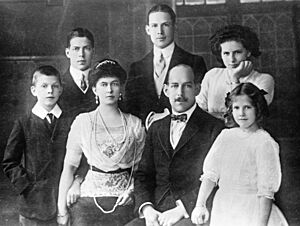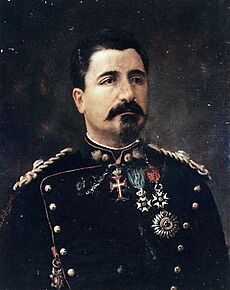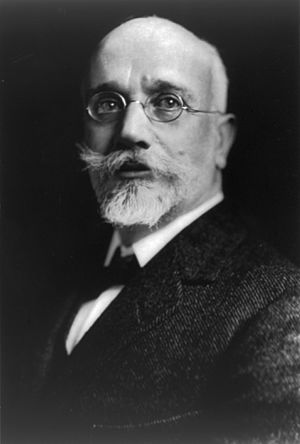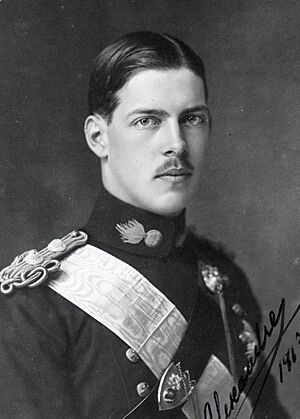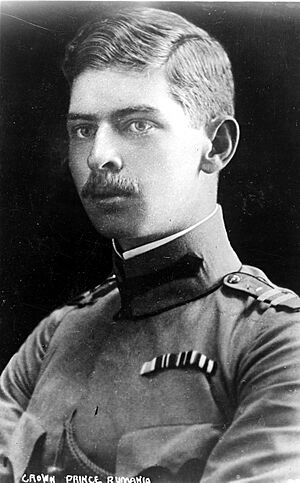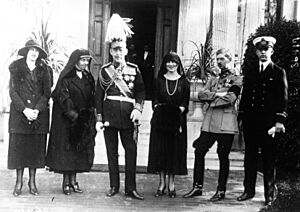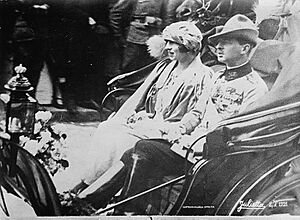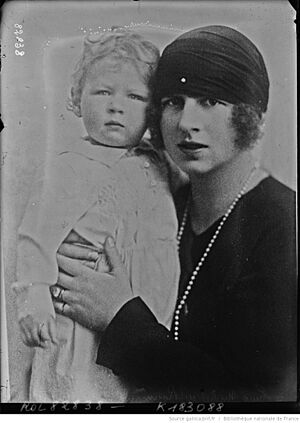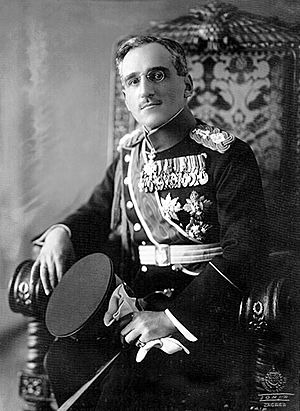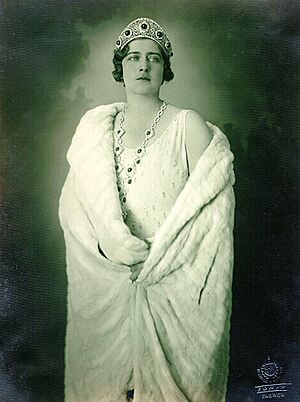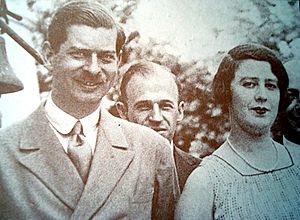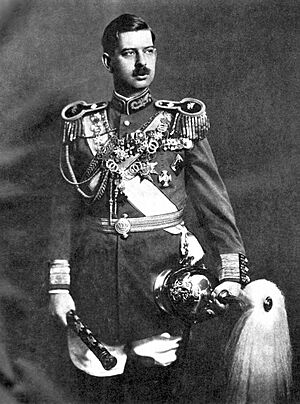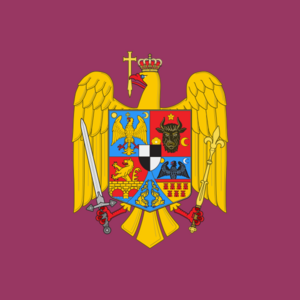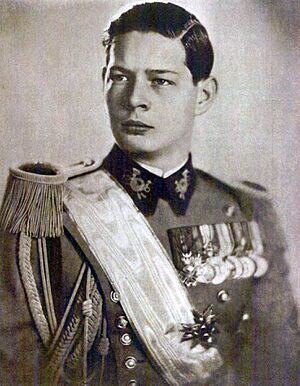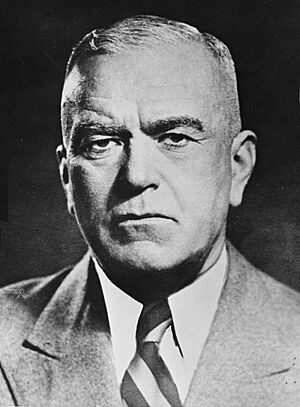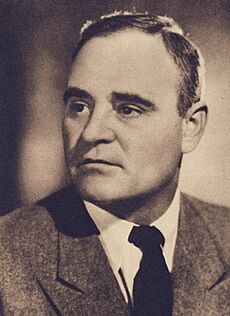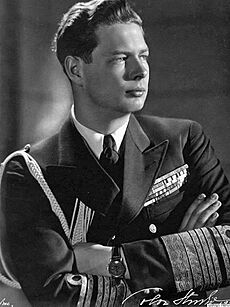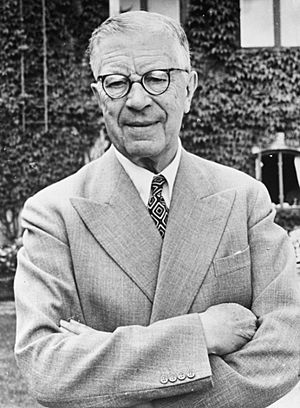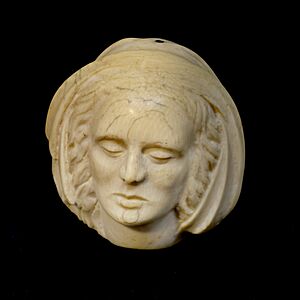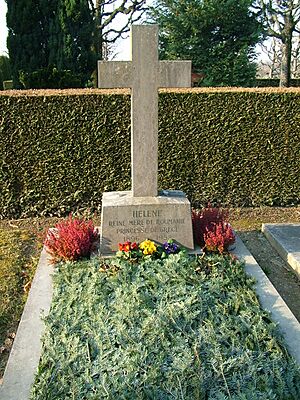Helen of Greece and Denmark facts for kids
Quick facts for kids Helen of Greece and Denmark |
|
|---|---|
| Queen Mother of Romania | |
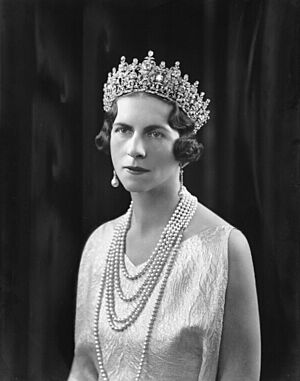
Photograph by Bassano, 1934
|
|
| Born | 2 May 1896 Old Royal Palace, Athens, Greece |
| Died | 28 November 1982 (aged 86) Lausanne, Switzerland |
| Burial | Bois-de-Vaux Cemetery, Lausanne, Switzerland (1982) The New Archbishopric and Royal Cathedral in Curtea de Argeș, Romania (2019) |
| Spouse | |
| Issue | Michael I of Romania |
| House | Glücksburg |
| Father | Constantine I of Greece |
| Mother | Sophia of Prussia |
| Religion | Eastern Orthodox Church |
| Styles of Helen, Queen Mother of Romania |
|
|---|---|
| Reference style | Her Majesty |
| Spoken style | Your Majesty |
Helen of Greece and Denmark (Greek: Ελένη, Eleni; Romanian: Elena; 2 May 1896 – 28 November 1982) was the queen mother of Romania. She held this title during the reign of her son, King Michael I (1940–1947). Helen is remembered for her brave efforts to help Romanian Jews during World War II. Because of her actions, the State of Israel honored her in 1993 with the title of Righteous Among the Nations.
Helen was the daughter of King Constantine I of Greece and Princess Sophia of Prussia. She grew up in Greece, the United Kingdom, and Germany. World War I and her father's removal from power in 1917 greatly affected her. She was also separated from her favorite brother, Alexander I of Greece. Helen lived in Switzerland with her family in exile. There, she spent months caring for her father, who was ill and sad.
In 1920, Princess Helen met Carol, Crown Prince of Romania. He quickly asked her to marry him. Even though Carol had a difficult reputation, Helen agreed. She moved to Romania and soon gave birth to their only son, Prince Michael, in 1921.
Helen often worried about her family in Greece. She traveled abroad to visit her parents or hosted them in Bucharest. This led to her growing apart from her husband. In 1925, Crown Prince Carol left his wife and gave up his right to the throne. He wanted to live openly with another woman. Helen was very upset and tried to get him to return. But she eventually agreed to a divorce in 1928. Meanwhile, in 1927, Helen was named "Queen Mother of Romania." This happened when her young son Michael became king under the rule of his uncle, Prince Nicolae.
However, Romania's political situation was unstable. Carol took advantage of this and returned to Bucharest in 1930. He was then made king. The new King Carol II forced his ex-wife into exile. He only allowed her to see their son for two months each year.
Helen moved to Villa Sparta in Fiesole, Tuscany, Italy. She stayed close to her family, hosting her sisters Irene and Katherine, and her brother Paul. They stayed with her until the Greek monarchy was restored in 1935. When World War II started, Carol II was removed from power. Romania also lost some of its land in 1940. These events brought Helen back to Bucharest to be with her son.
Under the rule of General Antonescu and watched by Nazi Germany, King Michael and his mother were careful. They did not openly oppose Romania joining the invasion of the Soviet Union or the deportation of Jews. But on 23 August 1944, King Michael organized a coup against Antonescu. Romania then turned against the Axis powers. However, the country was soon occupied by the Red Army.
After the war, the Soviet Union heavily influenced Romania's politics. In March 1945, King Michael had to accept a communist government led by Petru Groza. The next year, the general elections were rigged. This confirmed the PCR's power in the country. Finally, on 30 December 1947, King Michael I was forced to give up his throne. The royal family went into exile. Helen returned to Villa Sparta. There, she spent her time with family, gardening, and studying Italian art. As she grew older, her money became a concern. In 1979, Helen moved from Italy to Switzerland. She died three years later, in 1982, with her son by her side.
Contents
Helen's Early Life and Family
A Greek Childhood and Royal Family
Helen was born on 2 May 1896 in Athens, Greece. She was the third child and oldest daughter of Crown Prince Constantine and Princess Sophia of Prussia. Her grandfather, King George I, was ruling at the time. From birth, her brother Alexander called her "Sitta." This was his way of saying "sister." Helen grew very close to Alexander, who was only three years older than her.
Helen spent most of her childhood in the Greek capital. Each summer, she and her family sailed the Hellenic Mediterranean on the royal yacht Amphitrite. They also visited her grandmother, Dowager Empress Victoria, in Germany. From age 8, Helen also spent part of her summers in Great Britain. She grew up in a very anglophile (English-loving) home. She had British tutors and governesses, like Miss Nichols, who cared for her.
Challenges and Changes in Greece
On 28 August 1909, a group of Greek officers, called the "Military League," staged a coup d'état. This event, known as the Goudi coup, was against Helen's grandfather, King George I. The officers, led by Nikolaos Zorbas, wanted the king to remove his sons from military roles. They blamed Helen's father, Constantine, for Greece's defeat in the Thirty Days' War of 1897.
The situation was very tense. King George I's sons had to resign from their military posts to protect their father. Helen's father, Constantine, decided to leave Greece with his family. For several months, they lived in Germany. This was the first of many times that 14-year-old Helen would experience exile.
Eventually, the political situation in Greece calmed down. Constantine and his family were allowed to return home. In 1911, Prime Minister Eleftherios Venizelos restored Constantine to his military duties. A year later, the First Balkan War began. Greece gained large territories in Macedonia, Epirus, Crete, and the North Aegean. At the end of this war, King George I was assassinated in Thessaloniki on 18 March 1913. Helen's father then became King Constantine I.
After these events, Helen spent weeks traveling Greece. She visited Greek Macedonia and the battlefields of the First Balkan War with her father and brother Alexander. However, this peace was short-lived. The Second Balkan War started in June 1913. Greece won again, greatly expanding its territory by 68% after the Treaty of Bucharest.
World War I and Royal Exile
During World War I, King Constantine I wanted Greece to remain neutral. He felt the country was not ready for another conflict after the Balkan Wars. But Constantine had been educated in Germany and was related to Emperor William II. He was soon accused of supporting Germany and hoping the Allies would lose. The king disagreed with his Prime Minister Venizelos. Venizelos believed Greece should support the Triple Entente to achieve the Megali Idea (a vision of a larger Greece). In October 1916, Venizelos formed a separate government in Thessaloniki. Central Greece was occupied by Allied forces, and the country fell into a civil war, known as the National Schism.
Constantine I became very ill in 1915. He suffered from pleurisy and pneumonia and nearly died. Rumors spread that his wife, Queen Sophia, had injured him. This was said to be during an argument where she tried to make him fight alongside the German emperor. The king's health improved after a miraculous icon was brought to him. These events deeply affected Princess Helen, who was very close to her father. She became very religious, a trait she kept throughout her life.
Constantine I refused to change his policies. He faced growing opposition from the Triple Entente and Venizelists. On 1 December 1916, the Greek Vespers occurred. Allied soldiers fought Greek reservists in Athens, and the French fleet bombed the Royal Palace. Helen was almost hit by gunfire from the Zappeion. She ran to the palace gardens, worried for her father, but was quickly brought back inside by the royal guards.
Finally, on 10 June 1917, the Allied High Commissioner in Greece demanded the king's abdication. Under threat of invasion, the king agreed to go into exile. The Allies did not want a republic in Greece. So, they chose Constantine's younger son, Prince Alexander, to be the new king. This was because his older brother, George, was also seen as pro-German.
From Exile to Romanian Marriage
Life in Switzerland and Family Separation
On 11 June 1917, the Greek royal family secretly left their palace. They were surrounded by loyal supporters who did not want them to leave. Constantine I, Queen Sophia, and five of their children left Greece from the port of Oropos. They traveled to exile in Switzerland. This was the last time Helen saw her favorite brother, Alexander. The Venizelists, who were back in power, banned any contact between King Alexander I and the rest of the royal family.
Helen and her family settled in Switzerland, living in cities like St. Moritz, Zürich, and Lucerne. Most other members of the royal family soon joined them in exile. However, the family's money situation was difficult. Constantine I felt like a failure and became ill. In 1918, he caught the Spanish flu and almost died again.
Helen and her sisters, Irene and Katherine, spent a lot of time with their father. They tried to cheer him up. Helen also tried to contact Alexander I. She tried to call him by phone when he visited Paris in 1919. But the officer with the king refused to let her or other family members speak to him.
Meeting Crown Prince Carol of Romania
In 1920, Queen Marie of Romania visited the Greek exiles in Lucerne. She was Sophia's first cousin. Queen Sophia wanted her oldest son, George, to marry. He had already proposed to Queen Marie's daughter, Princess Elisabeth. George was homeless and had no real political power. He asked Princess Elisabeth to marry him again, and she finally accepted. Queen Marie then invited George, Helen, and Irene to Bucharest to announce the engagement. The princesses agreed to go on 2 October. Meanwhile, Elisabeth's brother, Crown Prince Carol, arrived in Lucerne. He had just finished a trip around the world.
In Romania, George, Helen, and Irene were welcomed with great ceremony. They stayed at Pelișor Castle. They were part of the celebrations for Crown Prince Carol's return (10 October) and Elisabeth's engagement (12 October). The Greek princes' stay was short. On 24 October, a telegram announced the death of Queen Marie's mother. The next day, another message said that Alexander I had suddenly died in Athens from a monkey bite.
Because of these sad events, the three Greek princes and Queen Marie decided to return to Switzerland quickly. Crown Prince Carol, perhaps encouraged by his mother, decided to travel with them. During Helen's stay in Romania, Carol had been cold and distant. But on the train journey, he suddenly became very attentive to her. They shared their life stories. Carol told Helen about his past relationship. Helen told him about her life and her deep sadness over Alexander's death. She said she did not want to return to Greece without her beloved brother. This open conversation made Helen fall in love with the Romanian heir.
Royal Wedding and New Beginnings
Soon after arriving in Switzerland, Crown Prince Carol asked Helen to marry him. Queen Marie was delighted, but Helen's parents were not. Helen was determined to accept. King Constantine I agreed to the engagement, but only if Carol's previous marriage was quickly ended. Queen Sophia was less happy. She did not trust the Romanian crown prince and tried to convince Helen to say no. But Helen insisted, and despite her mother's doubts, the engagement was announced in Zürich in November 1920.
Meanwhile, in Greece, Constantine I's supporters won the election on 14 November 1920. To settle the royal question, a referendum was held on 5 December. The results, though debated, showed that 99% of the people wanted the king back. So, the royal family returned to Athens. Helen was joined by her fiancé. For two months, they traveled Greece, exploring its ancient ruins. They then went to Bucharest for the wedding of George and Elisabeth of Romania (27 February 1921). After that, they returned to Athens for their own wedding. It took place in the Metropolitan Cathedral on 10 March 1921. Helen was the first Greek princess to marry in Athens. She wore the Romanian 'Greek Key' tiara, a gift from her mother-in-law. The newlyweds spent their honeymoon in Tatoi for two months. They returned to Romania on 8 May 1921.
Crown Princess of Romania
Life in Bucharest and Motherhood
When Helen returned to Romania, she was already pregnant. She stayed with Carol at the Cotroceni Palace. The formal court life both impressed and bored her. The couple then moved to the Foișor, a Swiss-style chalet near Peleș Castle, in Sinaia. There, Helen gave birth to her only child, Prince Michael, on 25 October 1921. He was named after Michael the Brave, a famous Romanian ruler. The birth was difficult and required surgery. Helen was very weakened, and doctors advised her not to have another pregnancy.
After Helen recovered, the couple moved to a large villa in Bucharest in December 1921. Despite having different interests, Carol and Helen lived a happy life for a while. Carol handled his official duties in the mornings. In the afternoons, they enjoyed their hobbies. Carol liked reading and collecting stamps. Helen enjoyed horseback riding and decorating their home. The crown princess was very involved in social work. She founded a nursing school in the capital. She was also made an Honorary Colonel of the 9th Cavalry Regiment.
Family Concerns and Marital Troubles
Meanwhile, the political situation in Greece was getting worse. The country faced unrest during the Greco-Turkish War. King Constantine I's health was also declining. Worried about her father, Helen asked her husband for permission to return to Greece. The couple and their child went to Athens in late January 1922. Carol left Greece in February to attend his sister Maria's engagement to King Alexander I of Yugoslavia. Helen stayed with her parents until April, then returned to Romania with her sister Irene. By this time, Carol had restarted a relationship with a former girlfriend.
In June 1922, Carol and Helen went to Belgrade with the Romanian royal family for Alexander I and Maria's wedding. Back in Bucharest, Helen continued her role as the heir's wife. She took part in official events and supported the king and her husband. Like many royal women, Helen was also interested in charity work. Still, she worried about her family. She visited her sister Irene, her aunt Maria, and her Greek cousins. She tried to find comfort in their company, as her parents were far away.
In September 1922, a military coup forced King Constantine I to give up his throne. His son George II became king. But George II had little power and was controlled by revolutionaries. After a failed pro-royalist coup in October 1923, he too was forced to abdicate after only fifteen months. Helen was devastated. She immediately went to Italy to be with her parents in exile. After King Ferdinand I and Queen Marie of Romania were crowned in Alba Iulia on 15 October 1922, Helen left for Palermo. She stayed there until her father's death on 11 January 1923.
Carol, bored by his wife's absence, invited his mother-in-law to stay in Bucharest. But she brought 15 Greek princes and princesses with her, without warning. Carol became increasingly annoyed by his wife's family. He was also upset by Helen's refusal to fulfill her duties as a wife. Carol suspected Helen was having a relationship with Prince Amedeo of Savoy. This led to Helen and Carol's separation. However, Helen kept up appearances by focusing more on raising her son, Prince Michael.
Crown Prince Carol's Renunciation
In November 1925, Carol was sent to the United Kingdom for a royal funeral. He refused to return to Bucharest. On 28 December 1925, Carol officially gave up his right to the throne and his royal duties.
In Romania, Helen was very upset by Carol's actions. Queen Marie even partly blamed her for the marriage's failure. Helen wrote to her husband, trying to convince him to return. She also tried to persuade politicians to delay Carol's removal from the line of succession. She even offered to travel to meet him. However, Prime Minister Ion Brătianu strongly opposed this. He disliked Carol. The Prime Minister sped up the process of removing Carol. He called Parliament to confirm Carol's renunciation and name young Prince Michael as the new heir.
On 4 January 1926, the Romanian Parliament approved Carol's renunciation. Helen was given the title "Princess of Romania." She also received money from the Civil list, a privilege usually for the king and heir. King Ferdinand I was diagnosed with cancer. So, a Regency Council was formed to rule during Michael's childhood. Prince Nicholas led it, helped by Patriarch Miron and a judge. Despite this, Helen still hoped Carol would return. She stubbornly refused his requests for a divorce.
In June 1926, Helen went to Italy for her paternal grandmother's funeral. She moved with her mother to a villa in Fiesole. Helen tried to meet Carol there. He first agreed, but then canceled at the last minute.
Michael I's First Reign and Helen's Exile
Queen Mother of Romania
In spring 1927, Queen Marie visited the United States. During her absence, Helen and her sister-in-law Elisabeth cared for King Ferdinand I, whose health was quickly worsening. The king died on 20 July 1927. His 5-year-old grandson, Michael I, became king. The Regency Council took over the country's leadership. However, Carol still had many supporters in Romania. The National Liberal Party began to fear his return.
After trying to convince Carol to come to Bucharest, Helen slowly changed her mind about him. To protect her son's rights, and likely convinced by Prime Minister Barbu Știrbey, Helen asked for a divorce. She easily got it. On 21 June 1928, the marriage was ended by the Romanian Supreme Court. Helen also grew distant from her mother-in-law, Queen Marie. Queen Marie complained about being separated from the young king and criticized Helen's Greek friends. Because of this, Queen Marie became closer to her eldest son, Carol, and supported his return.
The Regency Council struggled to govern Romania. Carol seemed more and more like the only person who could solve the country's problems. His supporters, like Prime Minister Iuliu Maniu, still wanted him to leave his girlfriend and get back with Helen. He refused. With many supporters, Carol finally returned to Bucharest on the night of 6–7 June 1930. He was welcomed with joy by the people and politicians. He then declared himself king, as Carol II.
Difficult Reconciliation with Carol II
When Carol II became king, he first refused to see Helen. But he wanted to meet his son, Michael. Michael was now heir to the throne with the title Grand Voivod of Alba Iulia. To see Michael, the king agreed to meet Helen. He visited her at her villa in Bucharest with his brother Nicholas and sister Elizabeth. Helen was cold towards her former husband. But she had no choice but to offer him her friendship for their son's sake.
In the following weeks, Helen faced pressure from politicians and the Romanian Orthodox Church. They tried to convince her to get back together with Carol II. They wanted her to be crowned with him at a ceremony on 21 September 1930. Despite her doubts, Helen agreed to a reconciliation. She considered canceling their divorce, but only if they had separate homes. So, they lived separately. Carol II sometimes had lunch with Helen, and she sometimes had tea with him at the royal palace. In July, the king, his former wife, and son traveled to Sinaia. Carol II stayed in one place, while Helen and Michael stayed at another. Every day, the family met for tea. On 20 July, Carol II and Helen appeared publicly together at a ceremony for King Ferdinand I.
In August 1930, the government proposed a decree to Carol II. It would officially confirm Helen as Her Majesty, the Queen of Romania. However, the king changed it. He declared Helen to be Her Majesty Helen (with the title Majesty, but not Queen). Helen refused to let anyone use this title in her presence. Because of this, the planned coronation was postponed. The return of Carol's girlfriend to Romania finally ended any hope of reconciliation. Soon, the king moved Michael to live with him. Helen was allowed to see her son every day, in exchange for her silence on political matters. Helen became more isolated. Her former husband forced her into exile. She agreed to a separation in October 1931. In exchange for her silence, and with help from her brother, former King George II of Greece, and her sister-in-law Elisabeth, Helen received a large sum of money. Carol II also allowed her to stay in Romania for four months a year. She could also have her son visit her abroad for two months. She kept her home in Bucharest, and the king paid for its upkeep. Helen also received money to buy a home abroad and an annual pension.
Queen Mother of Romania's Wartime Role
World War II and Antonescu's Rule
In Tuscany, Helen found peace, despite her son being away most of the year. However, World War II changed her life again. The Soviet Union forced Romania to give up land in June 1940. Weeks later, Romania also had to give up land to Hungary and Bulgaria. These losses ended the Greater Romania that was created after World War I. King Carol II could not protect his country's land. Under pressure from a fascist party, he was forced to give up his throne on 6 September 1940. His 18-year-old son Michael became king. General Ion Antonescu then set up a dictatorship with the help of the fascist party.
Antonescu wanted to gain the new king's favor. He also wanted to make his dictatorship seem more legitimate. So, he gave Helen the title of "Queen Mother of Romania" on 8 September 1940. He sent a diplomat to Fiesole to convince her to return to Bucharest. Helen returned to Romania on 14 September 1940. However, she found herself under the dictator's control. Antonescu wanted the royal family to have only a ceremonial role. He kept the king and his mother out of political decisions. He didn't even tell them when he decided to declare war on the Soviet Union in June 1941.
In this difficult time, Michael I sometimes felt depressed. Helen focused on helping him become more active. She asked historians to train her son for his role as king. She also guided him in his discussions and pushed him to oppose Antonescu when his policies seemed dangerous. Rabbi Alexandru Șafran warned Helen about the persecution of Jews. Helen personally asked the German ambassador and Antonescu to stop the deportations. She was supported by Patriarch Nicodim. King Michael strongly protested to Antonescu during the 1941 Odessa massacre. He managed to get Wilhelm Filderman, the head of the Romanian Jewish community, released.
Despite these efforts, Helen and her son mostly hosted German officers passing through Bucharest. The queen mother even met Hitler twice. Once informally, with her sister Irene, to discuss Greece and Romania's future in new Europe. And once formally with Michael I during a trip to Italy. Most importantly, Helen and her son had to officially support Antonescu's dictatorship. For example, Michael I gave Antonescu the title of Marshal after the Romanian Army took back land in August 1941.
In late 1942, Helen played a big part in stopping Antonescu's plan. He wanted to deport all Jews from Romania to a German death camp in Poland. According to a German report, Helen told the king that "what was happening...was a disgrace." She warned him that if the deportations didn't stop, she would leave the country. She said their names would be linked to crimes against Jews, and she would be known as the mother of "Michael the Wicked." As a result, the king called Antonescu, and a meeting was held.
King Michael's Coup and War's End
From 1941, Romania's army joining the invasion of the Soviet Union worsened relations between Antonescu and the royal family. They did not approve of taking over cities like Odessa and Kyiv. But it was the Battle of Stalingrad (1942–1943) and Romania's heavy losses that made Michael I organize resistance against Antonescu. In a speech on 1 January 1943, the king publicly spoke against Romania's involvement in the war against the Soviet Union. This angered Antonescu and Nazi Germany. They accused Helen of being behind the king's actions. In response, Antonescu tightened his control over Michael I and his mother. He threatened to end the monarchy if they caused any more trouble.
Over the next few months, the suspicious death of Tsar Boris III of Bulgaria and the arrests of princesses Mafalda of Savoy and Irene of Greece showed Michael I and his mother how dangerous it was to oppose the Axis powers. But the Soviets returning to Romania and American bombings over Bucharest forced the king to break with Antonescu. On 23 August 1944, Michael I organized a coup d'état against Antonescu, who was then imprisoned. The king and his new government declared war on the Axis powers. They asked Romanian forces not to fight the Red Army, which still invaded the country.
In revenge, the German air force bombed Bucharest. Casa Nouă, the king and his mother's main home since 1940, was largely destroyed. However, Romanian forces slowly pushed the Germans out of the country. They also attacked Hungary to free Transylvania. But the Allies did not immediately recognize Romania's change of sides. The Soviets entered the capital on 31 August 1944. An armistice was signed with Moscow on 12 September 1944. This forced Romania to accept Soviet occupation. A time of uncertainty began, with the Red Army making many demands.
Helen was visiting Sinaia during the royal coup. She found her son the next day in Craiova. Back in Bucharest on 10 September 1944, the king and his mother moved into the home of Princess Elizabeth. Helen was very worried about her son's safety. She feared he might be killed, like Prince-Regent Kiril of Bulgaria, who was shot by Communists. Helen also disliked the influence of Ioan Stârcea on the king. She was concerned about Carol II's plans to return to Romania. She also watched with worry as King George II struggled to regain power in Greece. In this difficult time, Helen was happy to learn that her sister Irene and nephew Amedeo were alive, though still held by Germans.
Despite these worries, the queen mother continued her charity work. She supported Romanian hospitals. She also managed to save some equipment from being taken by the Red Army. On 6 November 1944, she opened a soup kitchen in the Royal Palace ballroom. It served 11,000 meals to children in the capital over three months. Despite Moscow's opposition, the queen mother sent aid to Moldavia, where a terrible typhus epidemic was happening.
Rise of the Communist Regime
With the Soviet occupation, the Romanian Communist Party grew rapidly. Protests against the government increased. Acts of sabotage happened across the country, stopping the economy from recovering. The king faced pressure from the Soviet Union and the Communist Party. He needed a new government. He named Nicolae Rădescu as the new Prime Minister on 7 December 1944. But the situation remained tense. When the new Prime Minister called for elections, the Soviet Union started to cause trouble again. They wanted to put a government they liked in power. The United States and United Kingdom refused to help the king. He thought about giving up his throne, but changed his mind after advice from democratic leaders. On 6 March 1945, Michael I finally appointed Petru Groza, leader of the Ploughmen's Front, as the new head of government. This government had no members from the main democratic parties.
The Soviet authorities were pleased with this appointment. They became more cooperative with Romania. On 13 March 1945, Moscow gave control of Transylvania back to Bucharest. A few months later, Michael I received a prestigious Soviet military award. Still, the Soviet influence in Romania grew stronger. "Fascist" figures were removed, and censorship increased. A land reform was also put in place. This caused a drop in farm production and hurt exports. However, the king managed to temporarily stop the creation of "People's Tribunals" and the return of the death penalty.
After the Potsdam Conference, the Allies said that democratically elected governments were needed in Europe. Michael I demanded Petru Groza's resignation, but Groza refused. The king then started a "royal strike" on 23 August 1945. He refused to approve government actions. He and his mother stayed at the Elisabeta Palace for six weeks before going to Sinaia. But the West did not support the king's resistance. After the Moscow Conference in December 1945, they asked Romania to allow two opposition figures into the government. Helen was disappointed by the lack of courage from London and Washington. She was also shocked by Princesses Elisabeth and Ileana, who openly supported the communists. Helen, disgusted by these betrayals, encouraged fewer meetings with Soviet officials. She worried every day for her son's life.
The year 1946 saw the Communist dictatorship grow stronger, despite the king's active resistance. After months of waiting, the parliamentary elections were held on 19 November 1946. The Ploughmen's Front officially won. After this, the king and his mother's situation became more difficult. At their palace, they had no running water for three hours a day. Electricity was often off. This did not stop Helen from continuing her charity work. She kept sending food and clothing to Moldavia. In early 1947, the queen mother got permission to travel abroad to visit her family. She reunited with her sister Irene, who was weak after being deported. She attended the funeral of her older brother, King George II. She also went to the wedding of her youngest sister, Princess Katherine, to a British Major.
The signing of the Paris Peace Treaties on 10 February 1947, further isolated the royal family. The king had no official duties. He felt even more alone than during the "royal strike." Helen considered going into exile more seriously. But she worried they had no money outside Romania, as her son refused to save money abroad. Michael I and his mother were guests at the wedding of Princess Elizabeth of the United Kingdom to Prince Philip of Greece and Denmark (Helen's first-cousin) on 20 November 1947. This gave them a chance to travel abroad together. During this trip, the king fell in love with Princess Anne of Bourbon-Parma. He became engaged to her, which delighted Helen. This trip was also an opportunity for the queen mother to place two small paintings by El Greco from the royal collections in a Swiss bank.
End of Monarchy and Helen's Later Life
Michael I's Abdication and Early Exile
Despite advice from relatives to stay abroad to avoid the communists, the king and his mother returned to Bucharest on 21 December 1947. The government greeted them coldly. They secretly hoped the royals would stay abroad so they could abolish the monarchy. Since that plan failed, Prime Minister Petru Groza and the head of the Romanian Communist Party, Gheorghe Gheorghiu-Dej, decided to force the king to give up his throne. On 30 December 1947, they met with the king and his mother. The two politicians demanded Michael I sign a declaration of abdication. The king refused, saying the Romanian people should be asked first. The two men threatened that if he didn't sign, over 1000 students arrested would be executed. Thousands of people, including many students, had been arrested after clashes with Communist forces in November 1946. The Communist Party had falsified the votes for the 1946 Parliament elections, which the National Peasant's Party had won. Faced with this threat, Michael I gave up his crown. Hours after the announcement, the Romanian People's Republic was declared. Michael I and Helen left Romania on 3 January 1948. Despite their ties to the Communists, Princesses Elisabeth and Ileana were also forced to leave the country a few days later.
In exile, Michael I and Helen settled in Switzerland for a time. The former king sadly watched as Western countries accepted the communist republic in Romania. Helen was mostly worried about their money. The Communists allowed them to take almost nothing. The new Romanian authorities took over the former royal family's properties on 20 February 1948. They also took away the former monarch's and his relatives' nationality on 17 May 1948. At the same time, the king and his mother had to deal with Carol II's schemes. He still saw himself as the rightful ruler of Romania. He accused his ex-wife of keeping him away from their son. To achieve his goals, Carol II even involved other royal family members. Despite these worries, Michael I and his mother made several political trips. They visited the United Kingdom, France, and the United States. They met with government leaders and representatives of Romanians living abroad.
King Michael I's Wedding
Another concern for Michael I and his mother during their first months in exile was his marriage to Princess Anne of Bourbon-Parma. To make the former king look bad, Romanian authorities spread rumors. They said Michael I gave up his royal rights to marry the woman he loved, just like his father did in 1925.
The biggest problems were related to religion. Princess Anne was Roman Catholic. She needed special permission from the Pope to marry an Orthodox person. However, the Vatican was very unwilling to agree. This was because, for royal reasons, the couple's children would have to be raised in Michael I's Orthodox religion. Princess Anne's father, Prince René of Bourbon-Parma, failed in his talks with the Vatican. So, Helen decided to go to Rome with Princess Margaret of Denmark (Anne's mother) to meet Pope Pius XII. But the meeting went badly, and the Pope refused to approve the marriage. Because of this, Princess Anne had to go against the Pope's wishes and not have a Catholic wedding. This angered her uncle, Prince Xavier of Bourbon-Parma. He forbade his family members from attending the royal wedding. Helen tried to help, but without success.
Helen had better luck with her own family. Her brother, King Paul I of Greece, offered to host Michael's wedding in Athens. This was despite official protests from the Romanian government. The wedding was finally held in the Greek capital on 10 June 1948. Archbishop Damaskinos himself performed the ceremony. The wedding took place in the Royal Palace's throne room. Most members of the Greek royal family attended. However, no one from Anne's family or Carol II's family was there. Carol II was not invited, even though Helen had written to him about the marriage.
Exile and Final Years
Life at Villa Sparta
After Michael I and Anne's wedding, Helen returned to Villa Sparta in Fiesole. Until 1951, she hosted her son and his family. They visited her at least twice a year. Over the years, the former king's family grew. Princesses Margareta (1949), Elena (1950), Irina (1953), Sophie (1957), and Maria (1964) were born. From 1949 to 1950, Helen also housed her sister Irene and nephew Amedeo. They later moved to a nearby home. Helen and Irene remained very close until Irene's death in 1974. Helen also stayed deeply connected to Amedeo and his first wife.
Helen traveled often to visit her relatives. She regularly went to the United Kingdom to see her granddaughters, who were in school there. Despite sometimes having a difficult relationship with her sister-in-law, Queen Frederica, Helen spent long periods in Greece. She participated in the Cruise of the Kings in 1954. She also attended the wedding of Princess Sophia to the future King Juan Carlos I of Spain in 1962. She was also part of events celebrating 100 years of the Greek royal family in 1963.
Helen's life was not only about her family. She loved Renaissance architecture and painting. She spent much time visiting monuments and museums. She also created art, like an engraving made with a dentist's drill on an ivory billiard ball. She loved gardening and spent many hours with the flowers and shrubs at her home. She often visited the British Consulate and met intellectuals in Florence. From 1968 to 1973, Helen had a romantic relationship with King Gustaf VI Adolf of Sweden. They shared a love for art and plants. At one point, the Swedish king asked her to marry him, but she refused.
In 1956, Helen allowed Arthur Gould Lee to publish her biography. At this time, she faced money problems that worsened over time. The Romanian authorities still kept her income. But the queen mother financially supported her son. She also helped him find jobs, first as a pilot in Switzerland, then as a broker on Wall Street. Helen also supported her oldest granddaughter Margareta's studies. She even welcomed her at Villa Sparta for a year before she went to a British university. To do all this, Helen had to sell her belongings one by one. By the early 1970s, she had almost nothing left. In 1973, she mortgaged her home. Three years later, she sold the two Greco paintings she had brought from Romania in 1947.
Final Years in Switzerland
Helen became too old to live alone. In 1979, she left Fiesole. She moved to a small apartment in Lausanne, Switzerland, about 45 minutes from Michael I and Anne's home. In 1981, she moved in with them at Versoix. Helen, Queen Mother of Romania, died a year later on 28 November 1982, at age 86. She was buried simply in the Bois-de-Vaux Cemetery. The funeral was led by Damaskinos Papandreou, the first Greek Orthodox Metropolitan of Switzerland.
Eleven years after her death, in March 1993, the State of Israel honored Helen with the title of Righteous Among the Nations. This was in recognition of her actions during World War II to help Romanian Jews. She managed to save thousands of them from 1941 to 1944. The news was given to the royal family by Alexandru Șafran, who was then the Chief Rabbi of Geneva.
In January 2018, it was announced that the remains of King Carol II would be moved to the new Archdiocesan and Royal Cathedral. Queen Mother Helen's remains would also be moved there. The remains of Prince Mircea would also be moved to the new cathedral. His remains were at the Bran Castle's Chapel.
Queen Mother Helen of Romania was reburied at the New Episcopal and Royal Cathedral in Curtea de Argeș on 19 October 2019.
Archives
Queen Helen's letters with the Romanian diplomat George I. Duca between 1940 and 1982 are kept in the "George I. Duca Papers" collection at the Hoover Institution Archives in Stanford, California, USA.
Honours
 House of Hohenzollern-Signaringen-Romania: Knight Grand Cross with Collar of the Royal Order of Carol I
House of Hohenzollern-Signaringen-Romania: Knight Grand Cross with Collar of the Royal Order of Carol I



